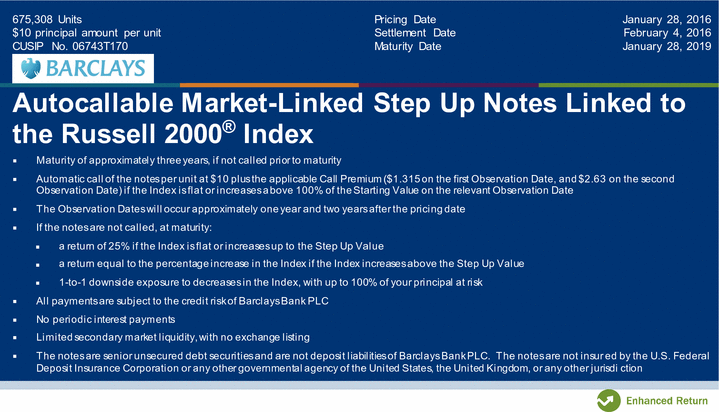Autocallable note pricing
Autocallables are quite commonly traded exotics with quite a few variations in structures. As the names suggests, these structures get automatically redeemed or autocalled when the the underlying price breaches the autocall barrier. Essentially the maturity of the trade is not fixed, the trade might autocall on any of the observation dates prior to final observation or expiry date.
Delta Quants - Risk analysis of Autocallable notes
Lets begin with the simplest autocall structure and later on we shall discuss some more complicated variations. Lets say we have a 4 year trade with annual observations.

Lets take the first scenario. The buyer gets back the notional at the end of the fourth year.

In the second scenario, the stock breaches the autocall barrier in the third year. Consequently, the trade expires in the third year. The buyer gets back the notional at the end of the third year.
An autocallable is a yield enhancing strategy. This would be the case when the market rallies, the investor would be happy to get his investment back which could be deployed in a more bullish strategy or simply in equity.
Autocallable feature in products
To understand the risk factors of an autocallable note it helps if we visualize the autocallable payoff as a series of digital payouts with each payout being contingent on the stock being above the coupon barrier on the given observation date but not being above the autocall barrier on any of the previous observation dates.
The risks of an autocallable would hence be quite similar in nature to the risks of a digital option. The buyer of the autocallable note would be long the forward meaning long the underlier, short the dividends and long the interest rates.
He would also be long the skew think of digital payouts as spreads. This is because the expiry of the autocallable is not fixed and depends on the performance of the equity. For simplicity we assume that the structure just has one autocall observation say 2 year after inception i. We assume that the structure is already delta hedged and the seller buys 2year and 5year zero coupon bonds to hedge his interest rate exposure.
Now do you start seeing why the stopping time expiry makes a difference. So if the equity increases, there is a higher probability that the structure will be autocalled after 2 years. The seller sells some of 5 year zero coupon bonds he holds and buys some more 2 year zero bonds. He would incur a net loss on selling 5 year zero bonds and buying 2 zero year bonds as the interest rates increased and hence price of the bonds decreased meaning that he sells the 5 year bond at a loss and the 2 year bond would be still cheaper to buy.
The impact would however be higher for a larger maturity compounding. Now if the equity falls meaning the interest rates also fall , the probability of the structure being autocalled decreases. So to hedge his exposure the seller sells some of his 2 year bonds and buys 5 year zero coupon bonds. Since the interest rates have also fallen, the bonds would have become more expensive. He makes some profit by selling 2 year bonds but he makes a net loss as the 5 year bonds would have become even more expensive.
Again the seller incurs a loss while hedging. So if the equity increases, the interest rates would fall on average so that the bond prices would increase.
Modeling autocallable structured products | SpringerLink
Increase in equity increases the probability of the structure being autocalled at the 2 year mark. To hedge the seller would sell some 5 year bonds and but 2 year ones. It can be argued in similar fashion and is left to the readers to do that the seller makes a net profit again when the equity falls.
If the investor thinks that the stock would never fall below a certain level during the life of the trade, he could could work up the coupon for the autocallable by adding a short down and in put feature to the structure. So in the resulting payoff, the buyer receives the autocall coupon whenever the stock is above the coupon barrier and the trade has not been autocalled.
In the final settlement either on the contractual maturity or when the trade gets autocalled, the buyer gets back the notional if the coupon barrier is never breached otherwise the actual return on the underlying stock if the coupon barrier is indeed breached on any of the previous observation dates. This feature is seen mostly when the autocall trigger level is equal to the coupon trigger level. It means that whenever the trade pays coupon it gets autocalled too.
Pricing Supplement -- SHLD Autocallable Notes
If the trade is still alive after i observations, the investor sometimes receives the sum of all previously missed coupon and hence snowball coupon. In the worst-of autocallable trades the buyer receives the coupon C whenever none of the underliers this a basket trade , is below the coupon barrier level. The trade pays back the notional when the trade expires i. In a variation of the above structure, the buyer could be short down and in worst of put.
This feature is generally added to increase the coupon at the risk of not receiving a portion or even the entire notional of the notional amount. A physicist thinks reality is an approximation to his equations. A mathematician doesn't care.
Risk analysis of Autocallable notes 3. I have my own problems to solve. I'm never likely to go there. I am just short the profit at the moment.